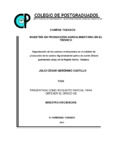| dc.contributor.author | Gerónimo Castillo, Julio César | |
| dc.creator | GERONIMO CASTILLO, JULIO CESAR; 346839 | |
| dc.date.accessioned | 2012-07-11T19:59:47Z | |
| dc.date.available | 2012-07-11T19:59:47Z | |
| dc.date.issued | 2012-07-11 | |
| dc.identifier.uri | http://hdl.handle.net/10521/764 | |
| dc.description | Tesis (Maestría en Ciencias, especialista en Producción Agroalimentaria en el Trópico).- Colegio de Postgraduados, 2012. | es |
| dc.description.abstract | La presente investigación se realizó en los municipios de: Jalapa, Tacotalpa y Teapa, Tabasco. La investigación describió el proceso vivido durante 13 años (1998 -2011) en la cadena productiva palma de aceite, se analizó quienes están participando y cómo se están dando las relaciones, para entender cómo está organizada esta cadena. Para lograrlo se realizó una caracterización de los actores participantes en la cadena, sobre todo en el eslabón de producción. A través de la metodología de redes se analizaron las principales interacciones existentes y se generó un indicador con el objetivo de medir las relaciones existentes entre los involucrados y que nos sirviera para detectar puntos críticos de intervención. Los principales resultados fueron que la organización de la cadena está dada por el interés de los participantes en el incremento de la superficie y la productividad por hectárea. Los productores se agrupan en 4 tipos: 1).- Empresariales, 2).- Transición I, 3).-Transición II y 3).- Auto abasto. Con base en este interés giran las relaciones existentes, relaciones que se encuentran centralizadas por actores dominantes en los diferentes temas y con densidades de relaciones muy bajas. Donde existe mas centralidad es el tema de mercados, asistencia técnica e insumos, con acciones centralizadas en pocos actores. Las densidades mas bajas están en los temas de investigación, el financiamiento y la organización. Se desarrolló un Índice ponderado de Relaciones (IPR) con cinco atributos de la red (Centralización de entrada, centralización de salida, densidad, intermediación y cercanía) y se tomó como base el estado actual de los actores calificados entre ellos. Se obtuvo un IPR de 0.34 en el eslabón de producción de la cadena agroindustrial palma de aceite, lo que indica que en materia de las relaciones posibles de la cadena hace falta el 66% para llegar al óptimo. _______________ ORGANIZATION OF THE ACTORS INVOLVED IN THE OIL PALM (ElaeisgineensisJacq.) AGRO-INDUSTRIAL PRODUCTION CHAIN LINK IN THE TABASCO MOUNTAIN RANGE REGION. ABSTRACT: | es |
| dc.description.abstract | This research was conducted in the municipalities of Jalapa, Tacotalpa and Teapa, Tabasco. This research describes the process that has been experienced for 13 years (1998 -2011) in the oil palm chain production, and describes who is involved and how the relationships are developing, , to understand how this chain is organized. To achieve this, a characterization of the actors involved in the chain, , especially in the production link, was carried out. Through the network methodology, the main existing interactions were analyzed and an indicator was developed in order to measure the existing relationships between the involved parties and detect critical points of intervention. The main results were that the organization of the chain comes from the interest of the participants in the increase of the area and and productivity per hectare. Producers are grouped into 4 types: 1). - Business, 2). - Transition I, 3), Transition II and 3). –Auto supply. The existing relationships revolve around this set of interests, relationships centralized by dominant players in the different activities with very low densities. The larger centralization exists in the areas of markets, technical assistance and inputs, with actions centralized in a few actors. The lowest densities are in the areas of research, funding and organization. It was developed a weighted index Relations (IPR) with five attributes of the network (input Centralization, output centralization, density, intermediation and closeness), which was based on the current status of qualified actors among them. A 0.34 IPR was obtained in the link of production of the oil agro-industrial palm chain, which indicates that with regards to potential relationships of the chain, it is needed 66% more to reach the ideal. | es |
| dc.description.sponsorship | Consejo Nacional de Ciencias y Tecnología (CONACYT). | es |
| dc.language.iso | spa | es |
| dc.rights.uri | http://creativecommons.org/licenses/by-nc-nd/4.0 | |
| dc.subject | Actores sociales | es |
| dc.subject | Cadena agroindustrial | es |
| dc.subject | Redes | es |
| dc.subject | Interacción y territorio | es |
| dc.subject | Social actors | es |
| dc.subject | Agribusiness chain | es |
| dc.subject | Networking | es |
| dc.subject | Interaction and territories | es |
| dc.subject | Producción Agroalimentaria en el Trópico | es |
| dc.subject | Maestría | es |
| dc.title | Organización de los actores involucrados en el eslabón de producción de la cadena Agroindustrial palma de aceite (Elaeisgineensis Jacq) en la región Sierra, Tabasco | es |
| dc.type | Tesis | es |
| Tesis.contributor.advisor | Martínez Becerra, Angel | |
| Tesis.contributor.advisor | Córdova Avalos, Víctor | |
| Tesis.contributor.advisor | Galmiche Tejeda, Angel | |
| Tesis.contributor.advisor | Cadena Iñiguez, Jorge | |
| Tesis.date.submitted | 2012 | |
| Tesis.date.accesioned | 2012-07-04 | |
| Tesis.date.available | 2012-07-11 | |
| Tesis.format.mimetype | pdf | es |
| Tesis.format.extent | 2,310 KB | es |
| Tesis.subject.nal | Elaeis guineensis | es |
| Tesis.subject.nal | Entorno sociocultural | es |
| Tesis.subject.nal | Sociocultural environment | es |
| Tesis.subject.nal | Entorno socioeconómico | es |
| Tesis.subject.nal | Socioeconomic environment | es |
| Tesis.subject.nal | Jalapa, Tabasco, México | es |
| Tesis.subject.nal | Tacotalpa, Tabasco, México | es |
| Tesis.subject.nal | Teapa, Tabasco, México | es |
| Tesis.rights | Acceso abierto | es |
| Articulos.subject.classification | Palma africana | es |
| dc.type.conacyt | masterThesis | |
| dc.identificator | 6 | |
| dc.contributor.director | MARTINEZ BECERRA, ANGEL; 200587 | |


